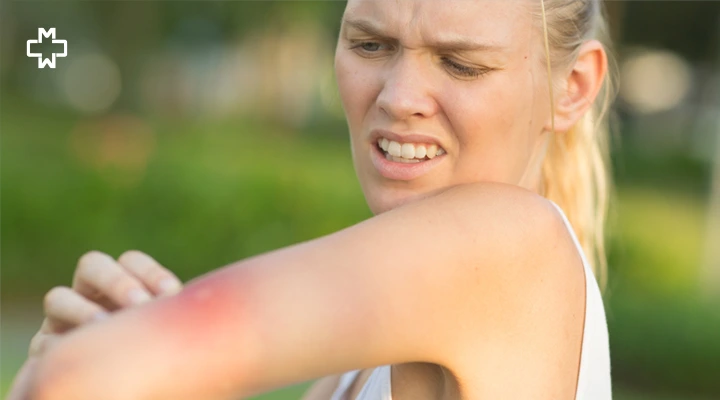Welcome to Manhattan Medical Art’s blog, where we strive to provide essential information to keep you and your loved ones safe and healthy.
In this article, we will be addressing a common concern: wasp stings and the potential swelling that may occur after 48 hours.
Understanding the typical response to a wasp sting and knowing how to respond can make all the difference in ensuring a smooth recovery. So, let’s dive into what you can expect, and the best course of action to take if you or someone you know has been stung by a wasp.
The Initial Wasp Sting Reaction
When a wasp stings, it injects venom into the skin, which leads to the body’s natural defense mechanisms being activated. In most cases, the initial wasp sting reaction includes pain, redness, and localized swelling around the sting site. This wasp sting reaction is entirely normal and is usually mild, subsiding within a few hours or a day.
Wasp Sting Swelling After 48 Hours: Is it Normal?
While immediate wasp sting swelling is normal and almost inevitable, some individuals may also experience delayed or persistent wasp sting swelling after 48 hours. This delayed wasp sting reaction might be concerning, but it’s crucial to understand that it is not uncommon. The extent of wasp sting swelling after 48 hours can vary depending on factors such as individual sensitivity to venom, the number of stings, and the location of the sting on the body.
Normal Signs of Swelling After 48 Hours
- Increased Size: The wasp sting swelling may continue to increase in size for up to 48 hours after the sting occurs.
- Redness & Warmth: The affected area may remain red and warm to the touch.
- Itching & Discomfort: Itchiness and discomfort can accompany the swelling.
- Limited Mobility: In some cases, wasp sting swelling can cause limited mobility in the affected limb or joint.
When To Seek Medical Attention
In most instances, delayed wasp sting swelling after a wasp sting is not a cause for immediate concern. However, there are specific warning signs that warrant seeking medical attention promptly. These signs may indicate an allergic reaction or an infection, which requires professional medical evaluation and wasp sting treatment.
If you or someone you know experiences any of the following symptoms, do not hesitate to seek immediate medical care:
- Difficulty Breathing:
Shortness of breath, wheezing, or throat tightness could be signs of a severe allergic reaction (anaphylaxis).
- Swelling Beyond Sting Site:
If the wasp sting swelling extends to other parts of the body away from the sting site, it may indicate a systemic allergic reaction.
- Severe Pain:
Intense pain or pain that worsens significantly after 48 hours could signal an infection.
- Pus or Discharge:
The presence of pus or any unusual discharge from the sting site suggests an infection.
- Fever:
A fever accompanying the swelling may indicate an infection.
How To Respond To Wasp Sting Swelling
For mild to moderate wasp sting swelling after a wasp sting, there are several steps you can take at home to promote healing and alleviate discomfort, such as:
- Clean The Area: Gently clean the sting site with mild soap and water to prevent infection.
- Apply a Cold Compress: Use a cold pack wrapped in a cloth to reduce wasp sting swelling and provide relief.
- Elevate The Area: If possible, elevate the affected limb to help reduce swelling.
- Over-The-Counter Pain Relievers: Non-prescription pain relievers like acetaminophen or ibuprofen can help manage pain and inflammation. Always follow the recommended dosage.
- Topical Ointments: Over-the-counter hydrocortisone cream can help soothe itching and irritation.
Conclusion
While most people experience only mild and short-lived wasp sting swelling after a wasp sting, some individuals may encounter delayed or persistent swelling as well. Understanding the difference between normal swelling and concerning symptoms is crucial.
If you or someone you know experiences severe symptoms or signs of wasp sting infection, seeking medical attention promptly is essential for proper evaluation and wasp sting treatment.
By knowing how to respond to wasp sting swelling, you can ensure a more comfortable and safe recovery process. Stay informed, stay safe, and always reach out to our healthcare experts at Manhattan Medical Arts for any inquiry or medical concern that might occur.
– Disclaimer –
This blog is for informational & educational purposes only, and does not intend to substitute any professional medical advice or consultation. For any health related concerns, please consult with your physician, or call 911.
-
About The Author
Dr. Syra Hanif M.D.Board Certified Primary Care Physician
Dr. Syra Hanif is a board-certified Primary Care Physician (PCP) dedicated to providing compassionate, patient-centered healthcare.
Read More







